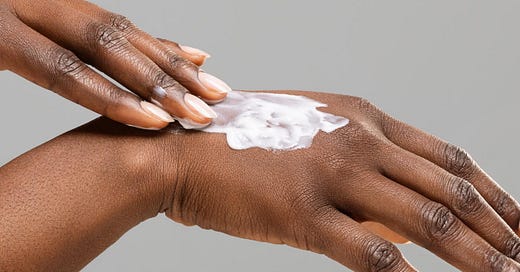Swaps #2 - Ingredients to be aware of in your lotions
As you may know by now, I’m all about clean living… and since our skin is our largest organ, it’s important to be aware of what we put on our skin.
As you may know by now, I’m all about clean living… and since our skin is our largest organ, it’s important to be aware of what we put on our skin.
Everyone’s used body lotion or creams from time to time, whether it be for hydrating dry skin, or getting that special glow.
Was there ever a time when you noticed that no matter how many times you put the lotion on, dry skin never seemed to disappear? Or what about that time when your skin got itchy and rashy all of a sudden? Many of the ingredients in our body lotion are known allergens and endocrine disruptors. Instead of hydrating our skin, they may be causing irritation and disturbing the integrity of our skin causing more dryness.
All types of body lotions contain preservatives. Microbial contaminants are a real issue. What about DIY or self-made products, you ask? Products made of entirely natural ingredients and containing absolutely no preservatives can quickly turn to mold once their shelf life expires. Preservatives are especially necessary in body lotions for this reason. Fortunately, few preservatives have been tested and were eventually deemed safe by experts. However, harmful preservatives should undoubtedly be avoided.
Let’s save the good news for last and sort through the bad ingredients first. You’ll find that I included EWG’s scoring of these compounds. 10 on the scoreboard is worst and 1 is best. Just for reference, I’d say anything above a 3 is quite harmful.
Parabens
Methylparaben, ethylparaben, propylparaben, butylparaben, isobutylparaben, isopropylparaben, benzylparaben and any pretty much any compound ending in “-paraben” make up the group of parabens. Parabens are the most commonly used preservatives in cosmetic products due to its extensive use in scents and fragrances. The most popular parabens in personal care products include methylparaben, butylparaben and propylparaben. Evidence supports exposure to parabens causes hormonal issues for both women and men.1 Parabens especially interfere with estrogen, the primary hormone found in females, explaining the concerning link to breast cancer.2 For men, parabens may adversely affect reproductive functions.
EWG’s scoring of parabens ranges from a timid 3 to a whopping 9.
Methylisothiazolinone (MIT), Methylchloroisothiazolinone (CMIT)
Methylisothiazolinone and methylchloroisothiazolinone have been found to cause allergic reactions with varying levels of severity.3 Skin irritation and burns occur with use of products containing MIT and CMIT. Individuals with skin sensitivity and conditions like eczema should never incorporate personal care products with MIT or CMIT into their routines. These compounds are prominently found in paint and slime.
EWG’s scoring of MIT and CMIT is 4-7 and 2-5, respectively.
Quaternium-15
Quaternium-15 is widely known to be an irritant for the skin and eyes, due to its direct connection to formaldehyde, a gas prevalent in household products. Exposure to quaternium-15 with formaldehyde resulted in allergic contact dermatitis in those utilizing lotions. 4
EWG’s scoring of quaternium-15 is a 5-7.
DMDM Hydantoin
Another compound with formaldehyde is DMDM hydantoin. It affects humans very similarly to quaternium-15, with such symptoms like skin and eye irritation and can also trigger allergies.
EWG’s scoring of DMDM hydantoin is a 6.
Imidazolidinyl urea
Here’s yet another compound containing formaldehyde producing the same health effects like allergic reactions and irritation.
EWG’s scoring of imidazolidinyl urea is 3-5.
Diazolidinyl urea
Diazolidinyl urea is also part of the formaldehyde releasing preservative family. It’s an allergen toxic to skin, causing irritation and reactions.
EWG’s scoring of diazolidinyl urea is 3-5.
Sodium hydroxymethylglycinate
Formaldehyde is again released from this particular preservative, sodium hydroxymethylglycinate. Its toxicity to the immune system labels it as an allergen which causes allergic reactions like sneezing and itchy, watery eyes.
EWG’s scoring of sodium hydroxymethylglycinate is 3-5.
2-bromo-2-nitropropane-1, 3 diol
Yup, you guessed it! Formaldehyde. 2-bromo-2-nitropropane-1, 3 diol is also a formaldehyde releasing agent. It’s especially toxic to the skin, eyes and the lungs. 2-bromo-2-nitropropane-1, 3 diol has been linked to flaring up allergic contact dermatitis in numerous studies, particularly one on the effects of Eucerin cream.5
EWG’s scoring of 2-bromo-2-nitropropane-1, 3 diol is 4-7.
Ok, phew. That was a lot. Honestly, I’m quite dumbfounded at the fact that not only are these preservatives in our everyday products, they’re ALLOWED to be. Can you believe the reason why parabens might not be found on the ingredients list is because under the term “fragrance”, it’s not information required to be disclosed? Mind-blowing! It’s crucial we know what we’re putting in and onto our bodies.
I think it might be time we explore the good preservatives list now…
Sodium Benzoate
Although its use is restricted in countries like Japan, there’s limited evidence to support severe toxicity to human organs.
EWG’s scoring of sodium benzoate is 1-3.







